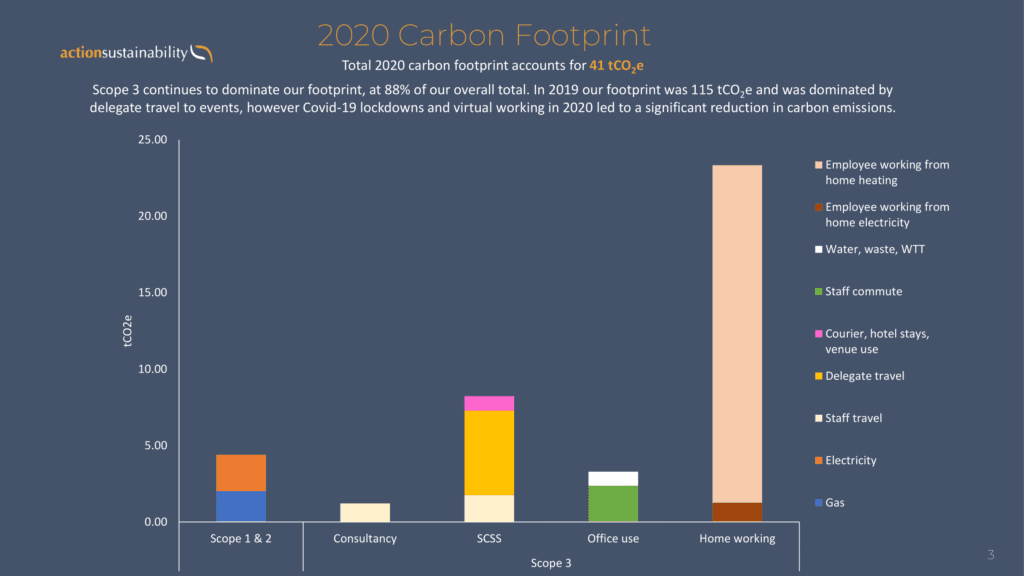Action Sustainability are an SME with around 30 employees, we’re based in London and our mission is to ‘inspire sustainable business’. We deliver carbon training through the Supply Chain Sustainability School and we help clients to understand, calculate, and reduce their carbon emissions. Which is why it’s important for you to know that we’re not only inspiring sustainable business, but we are a sustainable business ourselves – we walk the walk!
We’ve recently calculated our 2020 carbon footprint. A question we often hear is ‘How do I calculate my carbon emissions when I’m only an SME?’ and the answer is – with confidence! Whether you’re a small or large organisation, the process is the same: understand what aspects of your business operations are using energy and producing carbon emissions, collect the data and use Defra’s GHG conversion factors to work out your carbon emissions.
This is how we as an SME calculate our footprint. As you’re reading, think about how it could relate to your organisation…
The aspects of our business that use energy:
Our office is rented, so we asked our landlord for data on gas, electricity, waste and water use. We received data for the whole building, so based on the square footage of our office in comparison with the whole building, we apportioned down the data. For waste, we find it more accurate to apportion by the number of people, so the landlord told us the number of people in the building and we apportioned by the number of people in our office.
For scope 3 travel, our employees purchase train tickets through our Trainline for Business account, which means we can track the number of miles that have been travelled. For all expenses for travel, employees must detail the number of miles and mode of transport. We also collect information on staff commuting into the office: distance travelled, how often they visit and what mode of transport.
A key aspect of our business is delivering training through the School. In feedback forms we ask delegates the number of miles travelled and the mode of transport. It’s important for us to capture this information as delegates travel as a direct result of us hosting a training event. For training that we deliver in person, we also capture the number of hotel stays that staff have. Interestingly there are conversion factors specifically for hotel stays. We also make assumptions for courier use – i.e., miles travelled to deliver the training material.
Finally, the last assumption we make is venue use – every time we deliver a training session we’re using a venue so we make assumptions on the gas, electricity, waste and water use. Typically, the venues we use for workshops are a similar size to our office, so we use that data for approximations. For larger venues, we scale up our approximations.

Action Sustainability’s carbon footprint 2020 broken down.
The final aspects to account for were well-to-tank emissions, which are conversion factors that account for the upstream scope 3 emissions associated with extraction, refining and transportation. These are presented within Defra’s GHG conversion factors. Using Bulb’s methodology, we accounted for heating and electricity associated with working from home for 2020, as all employees worked from home for the majority of the year because of covid-19.
Once we collected all of the raw data mentioned above, we used the Defra GHG conversion factors to calculate the carbon emissions. Essentially, you multiply the raw data by the specific carbon conversion factor, and the output is the carbon emissions. You can also skip this manual part of figuring out what conversion factors to use by entering your data directly into the Carbon Calculator because the conversion factors are already set up.
For 2019, our total carbon footprint was 115tCO2e and the largest aspects were delegate travel to events (60% of our footprint) and staff air travel (5%). However, for 2020, covid-19 meant that from March, we worked from home, delivered all training virtually and took no flights. Therefore, our footprint reduced to 41tCO2e.
As a result of this decrease in emissions, we’re making the decision to remain virtual where possible and then deliver face-to-face training where there is added value. Employees are also continuing to work in a hybrid setting, i.e., they can work from home or the office as they wish.
Last year, we aligned with the Science Based Targets Initiative, committing to reduce our absolute scope 1 and scope 2 GHG emissions 46% by 2030 from our 2019 base year, and to measure and reduce our scope 3 emissions in alignment with a 1.5°C target. We have also made a Pledge to Net Zero, which is the environmental industry’s commitment to tackling GHG emissions.
The final step we took for our footprint was to offset our emissions using the Gold Standard to ensure that we’re using credible, robust, high-quality offsets. A carbon offset is a way to compensate for emissions produced by funding an equivalent carbon dioxide saving elsewhere. We asked all of our employees which schemes they were most interested in offsetting.
For 2019, employees chose a renewable energy and a clean water scheme. For 2020, employees chose: clean water access for families in Laos and planting biodiverse forests in Panama. We then bought the same number of credits as tCO2e that we produced this year. Each credit is equivalent to 1tCO2e offset and you pay per tonne; for example, if you produced 2tCO2e and you chose to offset against a scheme that cost £15 per credit, you would pay £30 to offset your carbon emissions.
This now means that we have acted carbon-neutral in 2020, as we have balanced out the total carbon emissions. Moving forward, we aim to reduce our carbon emissions to as little as possible, in line with our Science Based Targets, and then use offsetting where we can’t reduce, as a last resort.
If this all makes sense and you’re looking to calculate your own emissions, I’d recommend you take a look at the free carbon calculator.
If you’re confused and need advice, contact myself or our carbon expert Dr James Cadman know if you’re in need of support.
And finally, be confident! See how we as an SME have calculated our footprint above, attend a free School workshop on carbon footprinting, speak to your team and start calculating!

Imogen Player
Consultant
Imogen@actionsustainability.com

This was posted in All Topics, Energy & Carbon, ISO 20400 Sustainable Procurement
Our Head of Climate, Dr James Cadman, shares his insights on how organisations can effectively embed carbon reduction into their sustainable procurement practices using the ISO 20400 framework.
Read Article
This was posted in Energy & Carbon, ISO 20400 Sustainable Procurement
Developed by Action Sustainability, "Responsible Sourcing of HVO – A Comprehensive Guide" explores how to responsibly procure Hydrotreated Vegetable Oil (HVO).
Read Article
This was posted in Energy & Carbon, Sustainability Strategy
Action Sustainability is partnering with SKAO for the launch of the CO2 Performance Ladder pilot in the United Kingdom.
Read Article